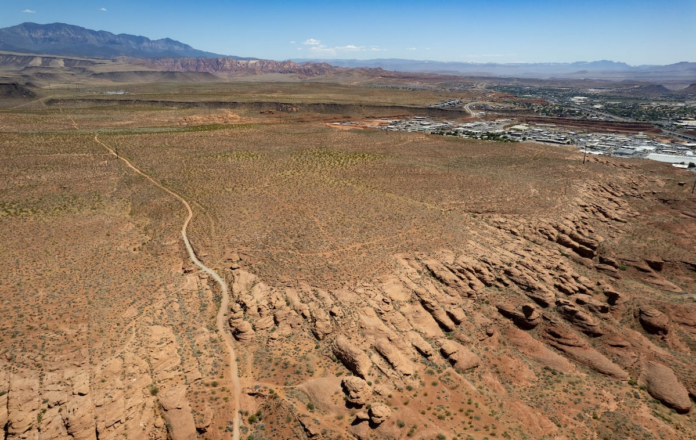A controversial highway through a national conservation area in southwest Utah is back on the table.
The Bureau of Land Management announced Friday that it is reassessing the Northern Corridor through the Red Cliffs National Conservation Area.
The feds have moved back and forth on the proposed highway since the Utah Department of Transportation applied for a right-of-way in 2018. The BLM and Fish and Wildlife Service previously approved the project in 2021 but then reversed that decision in 2024. Now, the BLM is reviewing highway options yet again because of new information provided by UDOT, according to an environmental analysis posted on Friday.
“By reassessing this application, we seek to balance our responsibilities as managers of the Red Cliffs National Conservation Area and as a neighbor to the growing communities within Washington County,” said BLM Color Country District Manager Gloria Tibbetts in a statement.
UDOT has been seeking a right-of-way for the Northern Corridor to reduce congestion and improve the flow of traffic between Interstate 15 and State Route 18 as Washington County rapidly grows.
Environmental groups have pushed back against this proposal though, as it would cut through a national conservation area that protects desert tortoise habitat and could increase fire risk and spread noxious weeds.
“According to the BLM’s 2024 analysis, the Northern Corridor Highway is a poor option for the St. George community, as it would increase fire probability and frequency, result in permanent loss to designated critical tortoise habitat, spread noxious weeds and invasive plants, and negatively impact cultural and historical resources,” said Holly Snow Canada, executive director of Conserve Southwest Utah.
Washington County is celebrating BLM’s reassessment.
“We’re excited that they’re taking another look at something that should not have been withdrawn in the first place,” said Washington County Commissioner Adam Snow. “The reasons that the Biden administration gave were completely and entirely political to acquiesce to some fringe environmental groups.”
Feds flip flop
BLM and the Fish and Wildlife Service first approved UDOT’s right-of-way application in January 2021, during the last days of President Donald Trump’s first term. In response, environmental groups, including Conserve Southwest Utah and the Southern Utah Wilderness Alliance, sued the Interior Department. The lawsuit resulted in a settlement agreement that required further environmental review and a new decision on the proposal, according to BLM’s latest environmental assessment.
Washington County then sued the feds over their supplemental analysis in August 2024 but the feds still moved forward with a final decision.
In December 2024, at the end of the Biden administration, the agencies revoked the previously granted UDOT right-of-way and endorsed an alternative called the Red Hills Parkway Expressway. This option would convert an already existing four-lane highway that runs along and through parts of the national conservation area.
After that decision, though, UDOT provided new information that showed “technical and economic infeasibility of the Red Hills Parkway Expressway alternative,” according to the environmental analysis BLM released on Friday.
The analysis specifies that the Red Hills Parkway Expressway would cost more than double the other alternatives that go through the conservation area and that some aspects of the proposal don’t meet Federal Highway Administration requirements.
UDOT’s right-of-way is back on
In its new environmental analysis released Friday, BLM identified the right-of-way it granted to UDOT in 2021 as its preferred alternative again. This route would be 4.5 miles long and include 1.9 miles of BLM lands.
If the agency chooses this option, it would also trigger the protection of lands in “Zone 6,” about 6,800 acres that were initially added to the reserve in 2021 to offset the impacts on desert tortoise habitat from the highway. When a highway through the conservation area was taken off the table, protections for Zone 6 also went away.
Zone 6 includes the greater Moe’s Valley area — a popular hiking, climbing and mountain biking destination. About half of the land is owned by the State Trust Lands Administration, which plans to develop the area in the absence of the Northern Corridor deal.
“It is critical to understand that the absence of the Northern Corridor north of St. George would have widespread negative repercussions — significantly impacting not only vehicular traffic but also the preservation of our precious open spaces,” said St. George Mayor Michele Randall in a press release. “We are confident that this initiative presents an opportunity for a beneficial outcome for our entire community.”
Snow said the county pledges to work with the Trump administration to “get the Northern Corridor back on track.” The county has been in conversation with the federal agencies and dismissed its lawsuit without prejudice in late September, according to Courtney Sinagra, the county’s deputy attorney and public information officer.
Meanwhile, Conserve Southwest Utah believes there’s a path to protect both Moe’s Valley and the Red Cliffs National Conservation Area, and they plan to continue fighting the highway.
“We are committed to safeguarding Red Cliffs National Conservation Area and the Greater Moe’s Valley Area, and we will continue to put all of our energy and resources behind protecting local public lands for the benefit of the local community,” said Snow Canada. “CSU and our partners across the state and nation are considering all our options to defeat the Northern Corridor Highway.”




